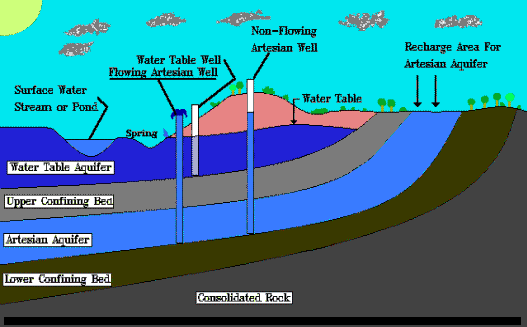| Groundwater Sources |
|
Figure 3 |
 |
|
The vast majority of accessible fresh water occurs, as groundwater thus responsible management of these is essential if we are to preserve clean freshwater. Figure 3 illustrates some of the mechanisms of water abstraction (removal). Ground water is the term given to water beneath the earth's surface. Contrary to popular belief this does not generally mean underground lakes or rivers. Ground water forms where the appropriate conditions exist to allow saturation of the soil levels below the surface. Good formations (sands and gravel's) permit, ease of water movement both from the surface and further into the subsoil. The amount of groundwater that can be obtained from an aquifer will depend on its formation and the frequency of recharge. Water falling on the land is absorbed into the soil and as more water falls is transported deeper under the surface forming saturated areas known as aquifers. The upper boundary of this area is the level of the water table, i.e. above this level the soil contains both air and water and is unsaturated. |
 |
| Aquifers are considered generally to be confined or unconfined, i.e. Some areas of saturation are covered by a layer of clay or impermeable rock, water therefore has to enter these areas indirectly from other adjacent areas known as "re-charge" zones. |
 |
|
The Water Table The water table is crucial in explaining and predicting the flow of wells and springs and the levels of streams and lakes. It is also an important factor in determining the extent to which pollutant and hazardous chemicals underground are likely to be transported by water. The water table can be mapped by observing the equilibrium level of water in wells, which is essentially the same as the top of the saturated zone. The water table varies with differences in permeability and water infiltration it is at surface level in the vicinity of swamps and frequently above the surface where lakes and streams are encountered. |